#ajrakhpur
Text

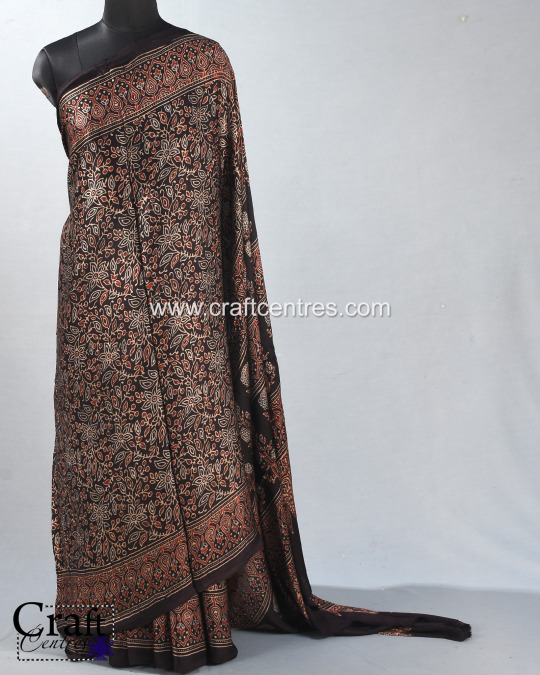
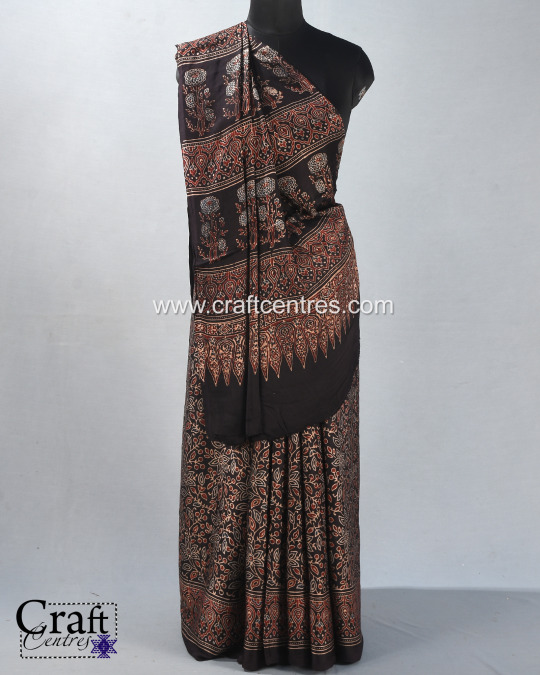
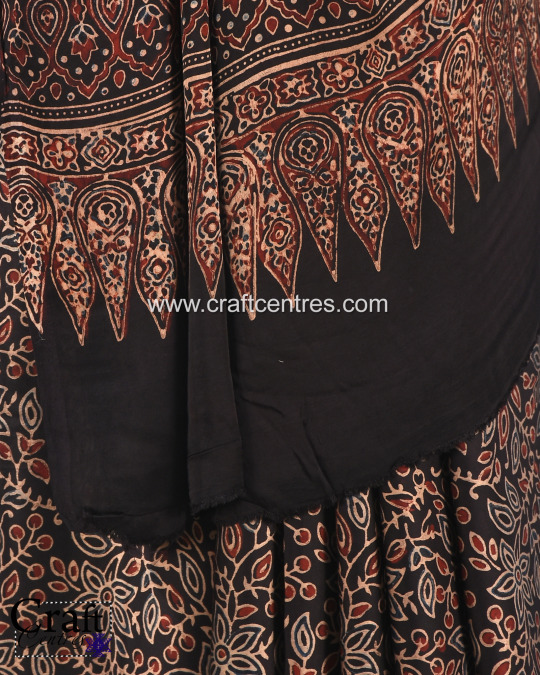

Ajarkh block print saree
0 notes
Text
The Art Ajrakh Prints: Origins, Techniques, Beauty of Ajrakh Saree Printing
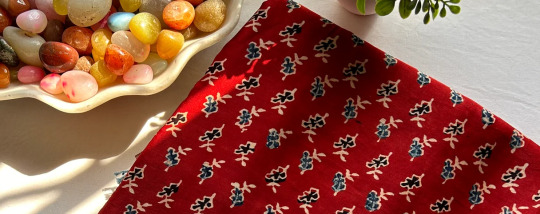
Ajrakh printing is a traditional textile art, celebrated for its intricate designs and natural dyes. Originating from the Sindh region, now in Pakistan, this craft has flourished in the Indian states of Gujarat and Rajasthan. This blog explores the fascinating world of Ajrakh sarees, delving into its rich history, unique techniques, and continued relevance in contemporary fashion.
What is Ajrakh Printing?
Ajrakh is a form of block printing that is distinguished by its color use and complex patterns. It involves a resist dyeing process similar to batik and is known for its eco-friendly approach:
Materials Used: Natural dyes derived from indigo, pomegranate seeds, and turmeric.
Technique: The fabric is printed on both sides by hand, using wooden blocks.
Significance: The motifs often symbolize nature and have deep cultural and spiritual significance.
How did Ajrakh Printing Originate?
The tradition of Ajrakh printing dates back over 4,000 years:
Historical Roots: Archaeological finds at Mohenjo-Daro suggest the presence of Ajrakh-like patterns.
Cultural Influence: This craft was patronized by the local communities of herders and agriculturists, reflecting their aesthetic and philosophy that emphasizes living in harmony with nature.
What Techniques Are Involved in Ajrakh Printing?
Ajrakh printing involves a labor-intensive process that can take up to two weeks to complete. The steps include:
Fabric Preparation: The cotton or silk is washed and treated to ensure it absorbs dyes properly.
Printing: Artisans skillfully apply the resist paste and use wooden blocks to imprint designs.
Dyeing: The fabric is dyed using multiple layers, separated by washing and drying.
Final Touches: After the last dyeing, the fabric undergoes a final wash to remove the resist and reveal the pattern.
Where Are Ajrakh Sarees Mainly Produced?
The key centers for Ajrakh printing in India are:
Kutch, Gujarat: Ajrakhpur is a village in Kutch famous for its Ajrakh artisans.
Barmer, Rajasthan: This region also specializes in Ajrakh, with local variations in style and technique.
Why is Ajrakh Printing Considered Sustainable?
Ajrakh printing is eco-friendly due to its reliance on natural resources:
Use of Natural Dyes: Minimizes chemical waste and pollution.
Water Recycling: The water used in washing the fabric is often treated and reused.
Holistic Approach: The entire process respects the balance of nature, using materials and methods that are environmentally sustainable.
Frequently Asked Questions about Ajrakh Printing on Sarees
How do I care for my Ajrakh saree?
Wash gently with mild detergent, and avoid prolonged exposure to direct sunlight which can fade the natural dyes.
Are there modern designs in Ajrakh sarees?
Yes, while traditional patterns are prevalent, many designers are incorporating modern aesthetics into Ajrakh to appeal to contemporary tastes.
Can Ajrakh printing be done on fabrics other than cotton or silk?
Yes, though cotton and silk are the preferred choices for their absorbency and smooth texture, Ajrakh can also be applied to other natural fabrics.
What makes Ajrakh sarees unique in the world of textiles?
The double-sided printing, intricate designs, and natural coloration process make Ajrakh sarees stand out as not just clothing but as pieces of art.
This exploration of Ajrakh saree art highlights not only its timeless charm but also its importance in the sustainable practices of modern fashion. Whether you're an enthusiast of traditional crafts or a fashion-forward thinker, Ajrakh sarees offer a blend of beauty, culture, and sustainability that is truly captivating. Discover the timeless charm and sustainability of Ajrakh sarees! This traditional textile art, originating from the Sindh region and now flourishing in Gujarat and Rajasthan, boasts intricate designs and natural dyes. Ajrakh sarees symbolize living in harmony with nature, making them not only beautiful but also eco-friendly. Shop for Ajrakh modal silk sarees from Myposhaakh and experience the blend of culture, beauty and sustainability that is truly captivating.
0 notes
Photo

🌸🌸Meet our little ajrakh workshop family🌸 @ajrakhprintofficial #ajrakhprintofficial . . . . . . . . #ajrakh #ajrakhprints #ajrakhlove #ajrakhpur #ajrakhprint #ajrakhblockprint #ajrakhhandblockprinting #handblockprinted #blockprinting #karigar #handblockprint #handblockprinting #handblockprintedtextiles #kutchwork #artistsoninstagram #kutchdiaries #craftlover #indiantextiles #handmade #craftblogger #craft #amazonkarigar #ajrakhsaree #ajrakhdupatta #ajrakhsarees #ajrakhworkshop #kutch #blockprint #supportsmallbusiness (at Bhuj Kutch) https://www.instagram.com/p/CZbK9BnM6rW/?utm_medium=tumblr
#ajrakhprintofficial#ajrakh#ajrakhprints#ajrakhlove#ajrakhpur#ajrakhprint#ajrakhblockprint#ajrakhhandblockprinting#handblockprinted#blockprinting#karigar#handblockprint#handblockprinting#handblockprintedtextiles#kutchwork#artistsoninstagram#kutchdiaries#craftlover#indiantextiles#handmade#craftblogger#craft#amazonkarigar#ajrakhsaree#ajrakhdupatta#ajrakhsarees#ajrakhworkshop#kutch#blockprint#supportsmallbusiness
1 note
·
View note
Photo

***Ajrakh Print Cotton Suit*** Top Fabric 2.5 meters Bottom Fabric 2.5 meters Dupatta Fabric 2.5 meters Price: Rs 1550/- only Free Shipping #ajrakh #ajrakhprints #saree #ajrakhlove #kalamkari #sustainablefashion #ajrakhprint #ajrakhsaree #dupatta #iwearhandloom #fashion #kutch #handloom #ajrakhpur #ajrakhfabric #weavesofindia #ajrakhdupatta #handblockprint #cotton #instafashion #handcrafted #ajrak #sareesofinstagram #sareepact #chanderi #ecofriendly #handblock #sarees #summer https://www.instagram.com/p/CEE6znYDUco/?igshid=1rdnc6nzclhzk
#ajrakh#ajrakhprints#saree#ajrakhlove#kalamkari#sustainablefashion#ajrakhprint#ajrakhsaree#dupatta#iwearhandloom#fashion#kutch#handloom#ajrakhpur#ajrakhfabric#weavesofindia#ajrakhdupatta#handblockprint#cotton#instafashion#handcrafted#ajrak#sareesofinstagram#sareepact#chanderi#ecofriendly#handblock#sarees#summer
0 notes
Photo
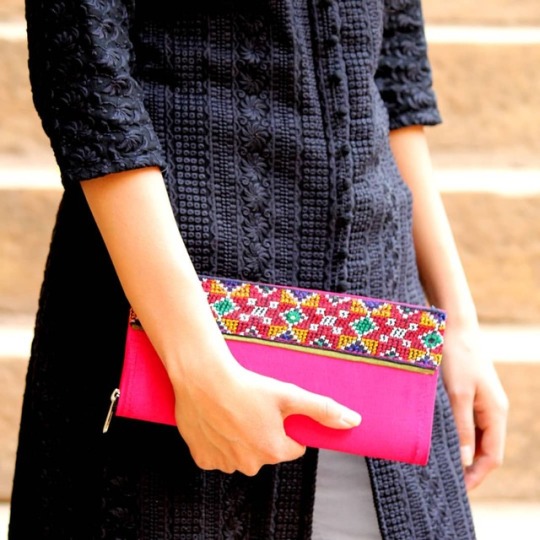
Well you can’t teach the poetry, but you can teach the craft. #mashroo #jatt #patti #wallet #ajrakhpur #handclutch #jatwork #embroidery #kutchi #handwork #handicraftlover❤️ #art #craft #handweaving #material #giftideas🎁 #kutch #bhuj #instashopping😍 #online #smartylooks🔥 #style #fashion #handmade #kutchicrafts #gifts #VCraft There's 1chain and 4pocket in-side. To place an order, DM us! https://www.instagram.com/p/BxWsJ2Ugg3e/?utm_source=ig_tumblr_share&igshid=16an7e8zu1xba
#mashroo#jatt#patti#wallet#ajrakhpur#handclutch#jatwork#embroidery#kutchi#handwork#handicraftlover❤️#art#craft#handweaving#material#giftideas🎁#kutch#bhuj#instashopping😍#online#smartylooks🔥#style#fashion#handmade#kutchicrafts#gifts#vcraft
0 notes
Text




Ajrakh is an ancient block-printing method on textiles that originated in the presentday provinces of Sindh in Pakistan and the neighbouring Indian districts of Kutch in Gujarat and Barmer in Rajasthan in India. According to some sources, the name comes from the Arabic word ajrakh, which means blue, one of the chief colours in ajrakh printing. Other historians say the word has been coined from the two Hindi words- aaj rakh, meaning, keep it today.
Ajrakh printing thrived in India in the 16th century with the migration of Khatris from the Sindh province to Kutch district. The king of Kutch acknowledged and recognized the textile art, and indirectly encouraged the migration of Khatris to uninhabited lands in Kutch. Ultimately, some Khatri printer families migrated to Rajasthan and settled in and around Barmer province of British India, including present-day Gujarat, and excelled at the art of ajrakh printing. At present, the Khatri community is engrossed in consistently producing jrakh printed fabric of supreme quality in Ajrakhpur village in Kutch and also Barmer.
In ajrakh printing, the fabric is first printed with a resist paste and then it is dyed. This process is repeated several times with different kinds of dyes with the aim of achieving the final design in the deep blue and red shade. This process consumes a lot of time. The longer the time span before commencing the next stage, the more rich and vibrant the final print becomes. Hence, this process can consume up to two weeks, and consequently results in the formation of exquisitely beautiful and captivating designs of the ajrakh.
1 / 2 / 3 / 4 / 5 | textile series
#ajrakh#ajrakh print#textiles#textile design#fashion#textile art#folk art#indian art#india#pakistan#gujarat#rajasthan#ots
166 notes
·
View notes
Photo



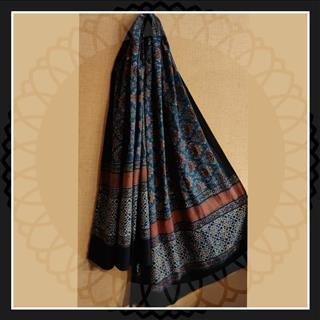


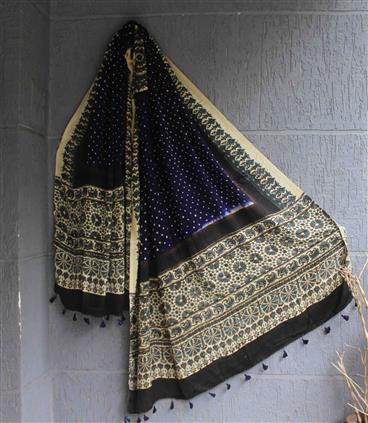
Navratri Ajrakh cotton Dupatta in Marron, Indigo, Shibori, Bandhej dupatta | Missori.in
A unique form of block printing done in Ajrakhpur region in Gujarat. Shop from an exclusive collection of Ajrakh Dupattas in Cotton
Enjoy ColorFul Navratri with ColourFul Collections from Missori Handmade
#shibori#ajrakh#bandhej#dupatta#cottondupatta#missori_handmade#navratri#garba#indigodupatta#onlineselling#onlinestore#handmadedupatta#handmade#shoponline#traditionaldupatta#ethnicdupatta#traditional#handmadestore#statementwear
2 notes
·
View notes
Photo

A Fusion of Kota doria and ajrakh *pure zari kota doria handloom ajrakh print saree* *Handwoven , gold zari, natural ajrakh print , natural dye* Length 6.50 full length #kotadoria #handloomsarees #ajrakhprint #ajrakhpur #kota #gujarat #rajasthan https://www.instagram.com/p/CPkQCtilMNv/?utm_medium=tumblr
0 notes
Photo

#Ajrakh #Cotton #Fabric #Wtsap 9979424233 www.AjrakhBlockPrint.com #Ajrakhblockprint #ajrakhfabric #cottonfabric #naturaldye #handmade #handicraft #ajrakhpur
#ajrakhfabric#fabric#cottonfabric#ajrakh#ajrakhblockprint#ajrakhpur#wtsap#cotton#handicraft#naturaldye#handmade
0 notes
Photo
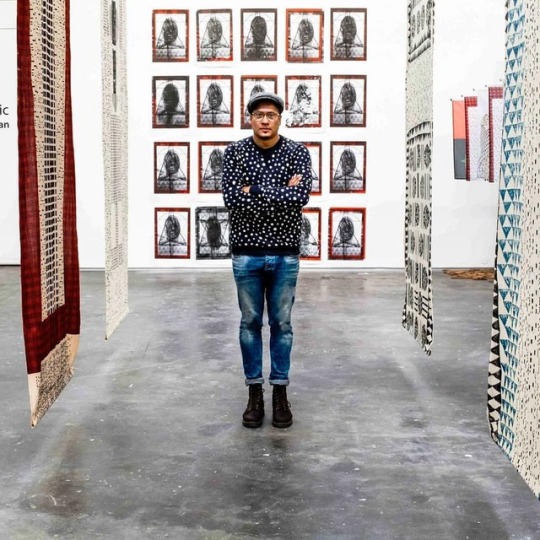
#finissage final three days of Monochromatic at @nieuwdakota #installation #show #monochromatic #blackink #adn #artista #panama #afro #barrelorgan #draaiorgel #artists #diaspora #artista #latinoamerica #antoniojoseguzman #music #artistas #culture #afropanama #amsterdam #amsterdam #damsko #mascara #teñido #afropunk #afroeuropean #textiles #india #sufiyankhatri #ajrakhpur
#music#latinoamerica#finissage#artista#sufiyankhatri#afroeuropean#blackink#textiles#teñido#artistas#diaspora#artists#india#damsko#mascara#installation#antoniojoseguzman#afropunk#ajrakhpur#afro#barrelorgan#draaiorgel#panama#show#afropanama#amsterdam#monochromatic#culture#adn
0 notes
Photo

%Title% #Ajrakhpur, #ArtOfTinyGujarat, #ColourfulCloth, #GlobalRenown, #SufiyanIsmailKhatri Click Here http://www.futurepostmagazine.com/art-tiny-gujarat-village-attains-global-renown/
0 notes
Photo

There is something Serene about Ajrakh , may be its the colours - earthen tones of indigo , crimson , brown & grey very close to the nature or may be its the prints - the harmony of floral & geometric prints like no where else , content & happy with each other or may be its the craft - precise , intricate and done with heart , more from the soul whatever it is lets enjoy these mystic drapes , make it a part of us and indulge in the bliss ! Smooth & Silky Modal silk Sarees with Mystic Ajrak Handblock prints , Adds a new flavour to a connoisseur's collection of Sarees . Flamboyant yet elegant , these Modal feel saree are here to win hearts ❤️! @ajrakhprintofficial #ajrakhsarees #ajrakh #ajrak #mumbaidesigner #heritageofindia #modalsilk #naturaldyes #handblockprinted #handblockprint #sareesofindia #artisanmade #ajrakhpur #ajrakhprintofficial #gangsofajrakhpur #manufaturerofajrakh #supportartisans #supportsmallbusiness #printedtextiles #handmadeinindia #kutch #ajrakhlove #ajrakhprint #handblock #handblockprinting #sareeonline #sareeinspiration #sareeswag #sareeoftheday #sareeday #sareesbanglore (at Bhuj Kutch) https://www.instagram.com/p/CPAFNnfJZn4/?utm_medium=tumblr
#ajrakhsarees#ajrakh#ajrak#mumbaidesigner#heritageofindia#modalsilk#naturaldyes#handblockprinted#handblockprint#sareesofindia#artisanmade#ajrakhpur#ajrakhprintofficial#gangsofajrakhpur#manufaturerofajrakh#supportartisans#supportsmallbusiness#printedtextiles#handmadeinindia#kutch#ajrakhlove#ajrakhprint#handblock#handblockprinting#sareeonline#sareeinspiration#sareeswag#sareeoftheday#sareeday#sareesbanglore
0 notes
Photo

I received these lovely gifts from my friend @kashifmisidia all the way from Pakistan! This beautiful shawl’s pattern is block printing called #ajarak or #ajrakh found in Sindh, Pakistan and Ajrakhpur, Kutch District, India. It is created using stamps. I learned this from the @sambara_travels in Karachi, Pakistan who provided some fantastic descriptive information! @kashifmisidia also sent me the most delicious cookies from @suaad ! What an awesome delicacy! #googlelocalguides #pakistan #sindh (at Bentonville, Arkansas) https://www.instagram.com/p/Cc18mvKsC5s/?igshid=NGJjMDIxMWI=
0 notes
Photo





#𝘿𝙖𝙮𝟯 - 𝗕𝗵𝘂𝗷
Our students attended Dr. Ismail Mohmed Khatri's Block Printing Workshop at Ajrakhpur.
Being an archaeologist, Dr. Ismail Mohmed Khatri discovered the oldest art form of South Asia. Around 5000 years ago, a block printing method was used which is still being practiced by the artisans from Kutch. Dr. Ismail Khatri Started a workshop of his own to sell on a global market and contributed a lot in the establishment of this art form.
ADMISSIONS ARE OPEN FOR 2022 BATCH FOR FASHION & INTERIOR DESIGN - 0% FINANCE AID AVAILABLE.
Diploma/Degree/Masters/International Certification courses
For admission related inquiries call us on +91 84337 77788 / +91 98922 33335
Connect us via CALL/VIDEO CALL/WHATSAPP/MESSAGE
INIFD MUMBAI GHATKOPAR - RANKED IN INDIA'S BEST 10 INTERIOR DESIGN INSTITUTE 2019
#INIFDMumbaiGhatkopar
#studytour
#bhuj
#rannofkutch
#day3
#DrIsmailKhatri
#BlockPrinting
#unforgettablememories
#learnwithfun
#masti
#AdmissionOpen
#Batch2022
#fashiondesign
#interiordesign
#proud2bdesigner
#diplomacourses
#degreecourses
#mastercourses
#internationalcertificationcourses
0 notes
Text
Buy Ajrakh Sarees Online: Ajrakh Block Print at Sillkpond
Ajrakh is one of the oldest block print techniques which is done using natural dyes like indigo and madder. You can find Ajrakh print bedsheets, dupattas, and sarees. What makes Ajrakh sarees special is the hand-block special printing on both sides and its range of colors. It originated from Rajasthan and Gujrat, India, but now has emerged in other parts of the world like Persian, Afghanistan, etc. Each piece of Ajrakh saree goes through several processes to retain the authenticity of Ajrakh sarees. If you’re willing to wear this gem of Rajasthan and Gujarat, visit Sillkpond to buy Ajrakh sarees online. We are a leading e-store in India delivering the best quality and unique designs under one roof.
Like Banarsi or Maheswari sarees, Ajrakh saree also contributes to Indian history. Ajrakh, the name derived from the small village Ajrakhpur situated in Gujrat. There, the Khatri community of Muslims has devoted their life to crafting Ajrakh. Since then, the Ajrakh craft has remained in the trend, and women love to wear Ajrakh sarees on any occasion, be it a party, small get-together, office, college, etc.
The reason why Ajrakh sarees are the most preferred choice of the ladies includes:
Ajrakh sarees are comfortable, soft, and exquisite. They are suitable for any occasion.They come in beautiful designs of block printing from natural dyes with vibrant colors.
Unlike other heavy sarees, they are easy to carry, maintain and drape. You can buy Ajrakh sarees online for daily wear as well.
These sarees have complex and iconic floral patterns that are hard to find in any other saree.
Ajrakh sarees have a timeless appearance; you can wear your grandmother's saree with the same finishing.
Another best part of Ajrakh sarees is that they are affordable. Anyone can buy intricate design, finest printing, and quality fabric at best prices.
Sillkpond introduces Ajrakh sarees in different patterns, varieties of colors with different fabrics. You can explore an exciting collection of sarees at our online store, whether you’re looking for sober Ajrakh sarees in Silk or Cotton fabric or want to buy embroidery saree online.
0 notes
Text
Indian Villages & its Weaving Tradition
It was quite fascinating to the scientists who studied the remains of the Harappa civilization in Mohenjodaro. The remains included various weaving equipment and self-preserved cloths. Throughout the ancient literature, we can also see weaving mentioned as something part of the living. We can find them in poems, dohas, and inscriptions on Indian temples and monuments. From this, we can clearly come to a conclusion that weaving started in India during the Vedic periods. The art of creating fabrics is an ancient tradition and technique.
But the number of handlooms and artisans has been decreasing substantially in the past decades. Pushing the artists to look for alternative sources of income. At the same time, it is also reported that the handloom association of India has reported more than Rs. 75000 Crore in revenue before the pandemic.
In this article, we are going to unravel the stories of Indian handloom and its traditions.
Indian weavers across the region
Before 50 years or so, weaving was one of the most employment-generating sectors in India. Across India, there were clusters of weavers that were making their crafts and selling them to the market.
There are mainly two types of weavers. One that weaves full time and the one that weaves after or during off seasons from farming. In rural villages, agriculture is still the dominant occupation.
The beauty of it was that each state or region had its own style of weaving and products. Some of them are still prevalent today. These occupational groups had special names and were being known as a caste. For example, Ansari and Momin are a type of caste where everyone is weavers. The people in their caste have strong links with their traditional occupations. The craft is learned by the new generation by hand to hand.
A decline in Rural crafts
Due to industrialization, there has been a steep decline in the number of people involved in traditional weaving practices. The decline was further catalyzed by the mechanization and cost advantage of manufactured products and the change in tastes of rural people and urban people.
A Story from Bengal
Weaving was practiced only by the people that belonged to the weaving caste. But as time passed, more and more people wanted to learn to weave and start their own units. People from various other castes began to learn to weave.
So the increase in weavers brought competition and internal conflict. Certain organizations started to form in villages to run the weaving units in an organized manner.
In the early days, the weavers used to sell their products directly to their customers. But as demand for handloom products started to increase, there was a gap for raising funds and dealing with international customers.
This situation resulted in creating a new set of people called the ‘Mahajans’ and ‘Paikars’. Mahajans were merchants who loaned money to weavers. But in turn, he would buy the products at a fixed price. This system also created a dependency on Mahajans. Paikars were the assistants of Mahajans who traveled across the region to lend money and collect products.
But this system corrupted the entire handloom industry as weavers got exploited. In the year 1945, the All India Handloom Board was set up by the Indian Government to boost handloom. But eventually, this system also failed and many weavers lost their earnings to Mahanjans as higher interest rates were imposed on their funds.
Contact us for Kalamkari fabrics
The modern importance of Handlooms
Traditional products are still in demand. People have a new set of values for such items. Besides, there have been many initiatives and CSR activities by companies like Microsoft to keep some of the traditional weavers busy and provide a growth path.
Block Printers of Ajrakhpur
A little village in Gujarat near Kutch is home to Ajrakh block-printed fabrics. It is one of the most loved items from India across the globe. The fabrics are dyed using natural colors derived from indigo, henna, turmeric, pomegranate, iron, and mud. Beautiful patterns and motifs are printed on these fabrics that are imprinted using hand-carved wooden blocks.
This community goes by the name Khatri, has been carrying forward this tradition for more than 300 years from Sindh, being passed down to sons from their fathers.
Contact us for Block printed fabrics
The contemporary amalgamation of handlooms
Recently handlooms and traditionally woven fabrics are highly sought after by boutique designers and popular international brands like IKEA. Kancheepuram from Tamil Nadu, Ikat from Odisha, Kalamkari from Andhra Pradesh, Brocade from Banaras, Bandhani, and Patan Patola from Gujarat, Bagalpuri silk from Bihar are some of the famous fabrics and items of modern India that still hold the traditional taste in the items.
Bollywood actors and stars are often seen to be wearing such items for international programs promoting the rich heritage of local Indian weavers.
Looking forward we can still see these traditional artisans being preserved for the coming centuries from losing the crafts. We can see more and more people choosing traditionally woven fabrics more in the coming years for their human touch and labor.
Where do you see the traditional weaving industry in the coming decades?
0 notes